EVALUATING THE ELF CHIMP OF FLORIDA - GLOWING GREEN AND VERY MEAN!
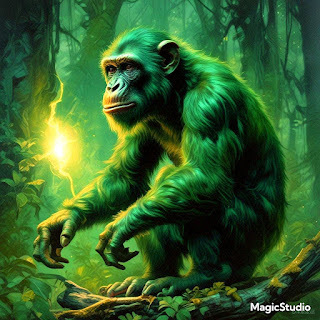 Isthis what the elf chimp looked like? (created by me using MagicStudio)
Isthis what the elf chimp looked like? (created by me using MagicStudio)My previous ShukerNature blog article wasdevoted to fictional green pigs (click here to read it), so now, continuingthis colourful theme, the current one presented here is devoted to a(supposedly) factual green chimpanzee.
As regular readers of my blog, books, andarticles will know well by now, I've always been attracted to the more unusual,little-known cryptids, and never more so than when they appear to be confinedto a single source, and with no apparent follow-ups either. So it was that when,many years ago, I read about the subject of this blog article of mine in justone solitary book and nowhere else, its details stayed in my memory, tofascinate but also frustrate me in equal measure. For in spite of havingsearched several times down through the years for additional information inother publications and widely online, I've never been able to uncover anyfurther details. Consequently, I've decided to present here in article form onShukerNature the scant details that I do have concerning what I have dubbed –for reasons explained later – the elf chimp of Florida, in the hope that myarticle might induce readers who may know more about this very curious cryptidto post their valuable information here.
My original – and only – source ofinformation (not counting, obviously, the numerous paraphrased versions of itthat have subsequently appeared in print and online) is John A. Keel's classicbook Strange Creatures From Time andSpace (USA 1970/UK 1976). A verbatim version of it later appeared in arevised edition of this book, published in 1994 and retitled The Complete Guide to Mysterious Beings.
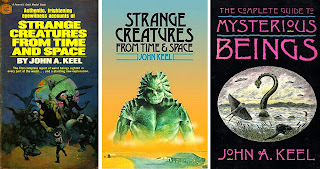 MyAmerican 1970 paperback, UK 1976 paperback, and American revised, retitled 1994paperback of the Keel-authored books noted above (© John A. Keel estate/FawcettGold Medal Books/Sphere Books/Doubleday Books – reproduced here on a strictly non-commercialFair Use basis for educational/review purposes only)
MyAmerican 1970 paperback, UK 1976 paperback, and American revised, retitled 1994paperback of the Keel-authored books noted above (© John A. Keel estate/FawcettGold Medal Books/Sphere Books/Doubleday Books – reproduced here on a strictly non-commercialFair Use basis for educational/review purposes only)
In both editions of Keel's book, therelevant excerpt appears as Case #15 within the Florida-themed section of achapter entitled 'Creatures from the Black Lagoon', and reads as follows:
"There's a terrible smellaround here. Can't you smell it?" the girl complained. She was one of fourteenagers parked in a Lovers' Lane near Elfers, [western] Florida, in January1967. As the others took deep breaths "an animal about the size of a largechimpanzee" sprang onto the hood [bonnet] of the car.
"Then we panicked!"the driver later told investigator Joan Whritenour. "The thing looked likea big chimp, but it was greenish [Keel'sitalics] in color, with glowing green eyes. I started the motor and the thingjumped off and ran back into the woods. We tore like blazes back to the dancewe were supposed to be attending."
A police officer from New PortRichey later visited the site and found a sticky green substance which remainsunidentified.
The investigator named in Keel's accountwas ufologist Joan Whritenour (who edited the ufological periodical Saucer Scoop). In 1967 she co-authoredwith famous mysteries researcher/writer Brad Steiger a book entitled Flying Saucers Are Hostile, followed ayear later by a second UFO-themed book, AllendeLetters. As I've never been a ufological researcher, however, I've neverowned a copy of either of these works, nor any issues of Saucer Scoop, so I have no idea whether they contain any mention ofthis case (although it's more cryptozoology-based than UFO-themed anyway). Consequently,could any ShukerNature readers who do own any or all of these publicationsplease check through them and let me know? Thanks very much! Sadly, neitherSteiger nor Whritenour are still alive, otherwise I'd have contacted them torequest further details regarding the 1967 Elfers incident.
Keel himself provided no primary sourcefor his above account's information, nor, as seen, did he attempt to assign anykind of identifying moniker to the green chimp (or chimp-like entity).Consequently, in order to make it more readily identifiable to and referable byfuture researchers, I have chosen to dub this creature the elf chimp – becauseit was seen near Elfers, and because the traditional elf-associated colour just so happensto be green.
 Theelf chimp was said to be greenish and to possess glowing green eyes (created byme using MagicStudio)
Theelf chimp was said to be greenish and to possess glowing green eyes (created byme using MagicStudio)
As a lifelong science-fiction movie buff(click hereto visit my film review blog, Shuker In MovieLand), when I read about thecreature's green colouration and the police officer's discovery of anunidentifiable sticky green substance at the site where the teenagers' encounteredit I readily recalled how such a substance, frequently some kind of deadlyradioactive spillage and/or of extraterrestrial origin, is a staple ingredientof sci fi-themed B-movies from the 1950s and 1960s. However, I personally doubtthat anything so (melo)dramatic was the identity of the green gloop in this reputedlyreal-life incident.
Shifting my attention to more prosaic possibilities,I recalled the many reported cases down through the years of so-called luminousowls, spied widely around the world, but especially in Europe, North America,and Australia – all regions that just so happen to harbour the pallid-plumagedbarn owl Tyto alba. Said to glow withintense brightness, sightings of mystery luminous owls have been discounted bysome scientists as observations of normal barn owls that have inadvertentlybrushed against bioluminescent fungi such as the honey fungus Armillaria mellea (which are sticky tothe touch, enhancing their adhesive capabilities) when perching in trees, withthese glowing fungi and their spores becoming attached to their feathers.Comparable fungi, including Armillariaonce again, also occur on the ground.
However, as swiftly pointed out byskeptics of this proposed solution, the total luminescence exhibited by acolony of such fungi in situ is still nowhere near as intense as has beenreported for a fair few luminous owls. This in turns means that even if barn owlsdid find themselves with some glowing fungal spores attached to their plumageafter having perched upon branches bearing them, the combined glow yielded bythese spores would obviously be less still than the total glow emitted by thecomplete colony of bioluminescent fungi on those branches.
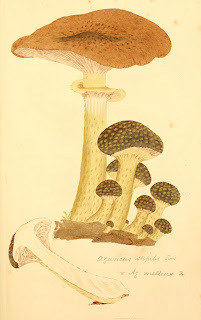 Honeyfungus Armillaria mellea, depicted ina vintage illustration from English naturalist/illustrator James Sowerby's Coloured Figures of English Fungi orMushrooms, 1789-1781 (public domain)
Honeyfungus Armillaria mellea, depicted ina vintage illustration from English naturalist/illustrator James Sowerby's Coloured Figures of English Fungi orMushrooms, 1789-1781 (public domain)
Consequently, I consider it highlyunlikely that even if it had climbed trees bearing glowing fungi and rolled onthe ground where glowing fungi were growing, the elf chimp encountered by theteenagers could have appeared greenish.
No details concerning the nature of thewoods from which it had emerged and back into which it had fled were includedin Keel's account, but I am wondering whether it contained any kind of largepool, pond, ravine, lake, stream, or some other body of freshwater. For if so,this might explain not only the elf chimp's colour but also its vile smell.Such bodies of freshwater in Florida and in many other localities around theworld all too regularly experience, especially during the summer months, thedetrimental phenomenon of algal blooms.
An algal bloom is defined as a rapidgrowth of microscopic true algae or of cyanobacteria in water, which oftenresults in a coloured scum appearing on the water surface. In marine bodies ofwater, these blooms are often red in colour, are caused by true algae, and someare known as red tides (but green ones also occur, depending upon the algalspecies involved), whereas in freshwater they are frequently bright green orbluish-green, and are caused by autotrophic gram-negative bacteria correctlyreferred to as cyanobacteria but which on account of their superficiallyalga-like outward appearance are popularly albeit inaccurately dubbedblue-green algae.
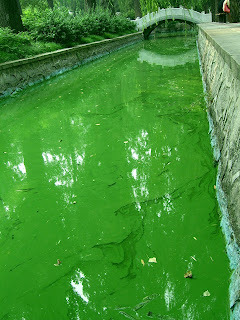 Abright green example of a severe freshwater algal bloom (public domain)
Abright green example of a severe freshwater algal bloom (public domain)
Algal blooms result when algae or cyanobacteria multiply quickly inwaterways with an overabundance of nitrogen and phosphorus (often caused byfertilizer having been dumped into them), particularly when the water is warmand the weather is calm. Moreover, they can have harmful effects upon thehealth of humans and other animals if water containing a bloom is touched, swumin, swallowed, or when airborne droplets are inhaled. They also emit a foul,putrid smell that can irritate, and they clog the gills of fishes swimming inwater polluted by them.
Florida's freshwater bodies areparticularly prone to algal blooms – indeed, in summer 2023 a toxic cyanobacterialbloom was covering roughly half of Lake Okeechobee, Florida's largest inlandlake (click here to access a news report concerningthis disturbing turn of events). In short, if the elf chimp had entered a bodyof freshwater containing a cyanobacterial bloom, whether deliberately oraccidentally, it could well appear greenish in colour, with the severeirritation to its skin conceivably explaining its belligerent behaviour, andthe stench emitted by the cyanobacterial bloom's scum even explaining thiscreature's awful stink as noted by the teenagers.
On the negative side of any explanation involvingalgal blooms is that the encounter took place in January, whereas these bloomsare most prominent during the warm, sunny summer months. Furthermore, if thebody of water where an algal bloom might potentially develop is ensconcedwithin a dark secluded forest with little sunlight penetrating through thetrees, this is far from ideal for a bloom's development, as the latter requiresplenty of sunlight to stimulate its growth via photosynthesis. And if thesticky green substance found at the site near Elfers by the police officer wereindeed from an algal bloom (or from glowing fungi for that matter), why couldit not be identified? Algal blooms (and glowing fungi) were already familiarphenomena, scientifically speaking, back then.
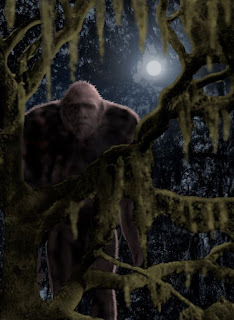 Artisticrepresentation of the Florida skunk ape (© William M. Rebsamen)
Artisticrepresentation of the Florida skunk ape (© William M. Rebsamen)
Also needing to be considered is whether,in spite of its eyewitnesses' likening it to, or even directly identifying itas, a chimpanzee, the creature really was a chimp. An absconded exotic pet oran escapee/release from a private collection or menagerie certainly offerplausible explanations for why such a creature might be existing in a woodlandnear Elfier. However, there is also the intriguing possibility that it may besomething truly cryptozoological – possibly a juvenile bigfoot, or, morespecifically, a Florida skunk ape.
The reason that I proffer this option forconsideration is that in the very same Florida-themed section of his book's'Creatures from the Black Lagoon' chapter, Keel included as Case #14 anotherencounter with a hairy green-eyed green-glowing foetid creature of unidentifiednature, but much larger than the elf chimp and more suggestive of a typicalbigfoot entity. Again, he provided no source for his information, but here ishow he described the encounter:
A young woman was changing atire on a lonely stretch of highway outside Brooksville, [western] Florida, onWednesday night, November 30, 1966, when she heard a noise in the bushes andbecame aware of a most unpleasant odor. Then a huge thing with large green eyeand an eerie greenish glow on one side of its hairy torso stood up beside theroad and studied her. She was terrified. The creature walked off into the woodswhen another car came along and stopped.
Worth noting here is that Brooksville andElfers exist in adjacent counties within western Florida, with Brooksville amere 38.7 miles north of Elfers.
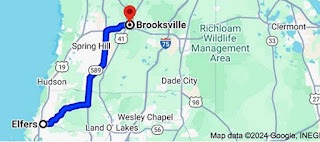 Mapshowing the proximity of Elfers to Brookesville, both situated in western Florida (© Google Maps– reproduced here on a strictly non-commercial Fair Use basis foreducational/review purposes only)
Mapshowing the proximity of Elfers to Brookesville, both situated in western Florida (© Google Maps– reproduced here on a strictly non-commercial Fair Use basis foreducational/review purposes only)
Partial but not full-body contact with ancyanobacterial bloom could explain why only part of the torso of theBrooksville beast was glowing green – as an adult (judging from its huge size),the creature would be more experienced and wary about immersing inbloom-polluted water than a juvenile would be. Of course, as with the elf chimpcase, the time of year in which this encounter occurred is outside the peaktime for algal blooms, but some can exist all year long. Alternatively, had oneside of its thorax simply brushed against some glowing fungi in theundergrowth?
Green glowing eyes have often beenreported in bigfoot sightings (so too have red glowing eyes). This suggeststhat whatever the species responsible, a tapetum lucidum, i.e. alight-reflecting cell layer, is present at the back of each eye, behind theretina, as is commonplace in nocturnal mammals, assisting these creatures tosee in dim light (by reflecting incoming light back out again through theretina, thus causing the reported glow or eyeshine).
However, as apes and monkeys are almostexclusively diurnal (only the Central and South American douroucoulis aka nightor owl monkeys are habitually nocturnal, as well as lower primates such aslemurs and lorises), their eyes do not possess a tapetum – indicating,therefore, that whatever it was, the elf chimp was not a true chimp.
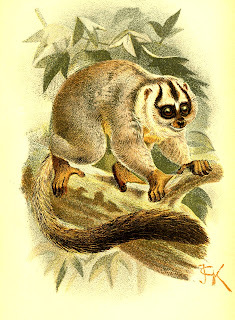 Adouroucouli depicted in an exquisite vintage illustration from 1894 by JohnGerrard Keulemans (public domain)
Adouroucouli depicted in an exquisite vintage illustration from 1894 by JohnGerrard Keulemans (public domain)
Having said that: an uncategorisedspecies of ape that has evolved to be nocturnal might be expected, therefore, tohave evolved such an adaptation. Again, the douroucoulis provide a precedenthere. For although they do not possess a true tapetum, i.e. composed ofriboflavin crystals (which nocturnal lemurs have), they do possess an analogousversion composed of collagen fibrils, indicating that their nocturnal lifestyleis a secondary adaptation evolved from ancestral species that were diurnal inlifestyle.
In short, glowing green eyeshine at nightdoes not necessarily rule out an ape identity for the bigfoot. Equally,however, those who favour a bear as this famous cryptid's true identity pointto the fact that bears' eyes do possess a true tapetum and shine at night, theprecise colour varying from red or orange to yellow or green, depending upon anumber of different factors (and thereby making conflicting reports of greeneyeshine and red eyeshine for the bigfoot less problematic).
As noted at the beginning of thisShukerNature blog article, I am unaware of any sequel to these cases, or theoriginal source material (newspaper reports?) upon which Keel based hisaccounts. Does any additional coverage exist, for example, that names theteenagers and/or the police officer, which could therefore enable them to betraced and interviewed if still alive? Gathering further first-hand eyewitnesstestimony from them might yield new, extremely valuable details. Someone withready access to the archives of local newspapers for Elfers and Brooksvillemight uncover such source material, which is why I have prepared this article –as a spur for further research by those better-placed geographically to conductit than I am, living in Britain. It would certainly be fascinating to knowwhether the elf chimp and its much larger green-furred Brooksville counterpartwere ever reported again, rather than being once-witnessed wonders of the kindall-too-frequently found hidden away in the cryptozoological archives.
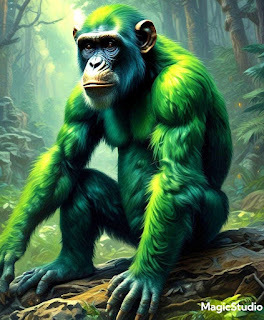 Theelf chimp – mean, green, and seen, but only once? (created by me using MagicStudio)
Theelf chimp – mean, green, and seen, but only once? (created by me using MagicStudio)
Karl Shuker's Blog
- Karl Shuker's profile
- 45 followers



